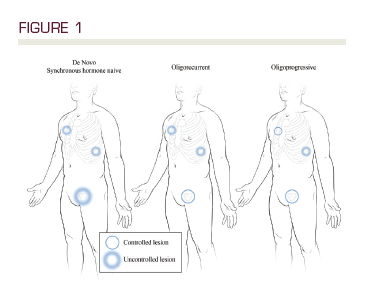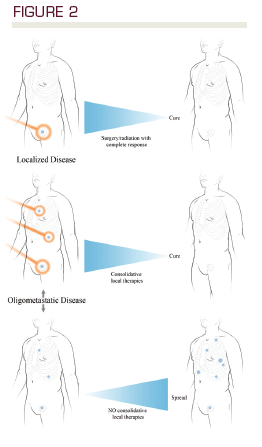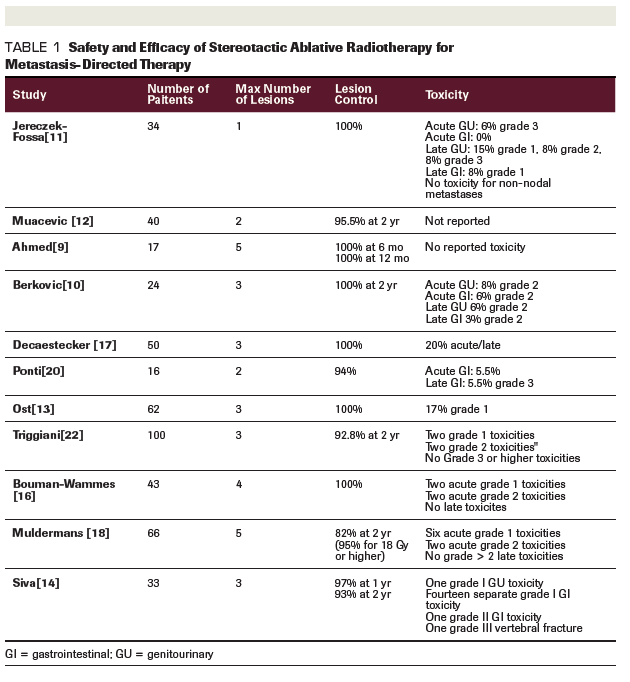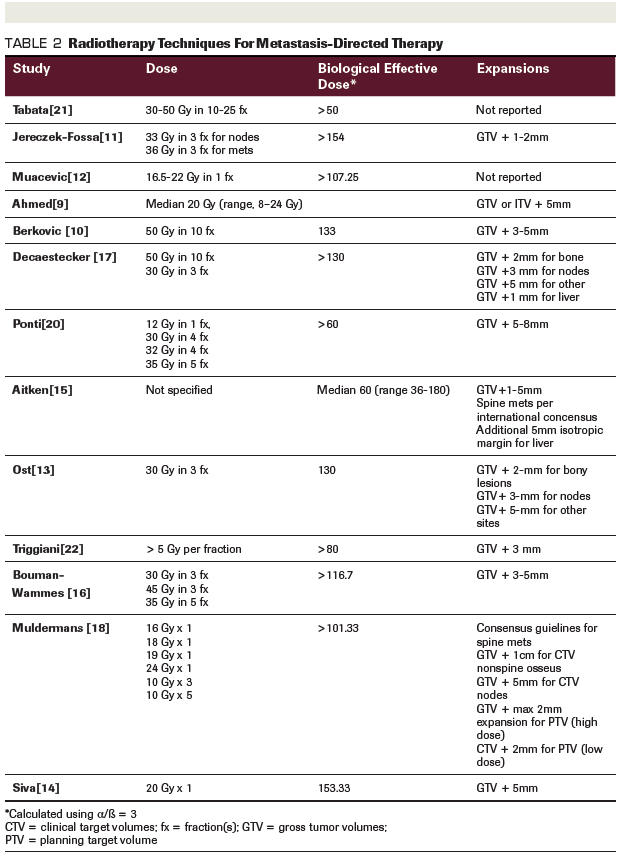Metastasis-Directed Therapy in Prostate Cancer. Why, When, and How?
Metastasis-directed therapy with stereotactic ablative radiotherapy has emerged as a promising complementary technique for the management of low-volume metastatic prostate cancer.
FIGURE 1

FIGURE 2

TABLE 1: Safety and Efficacy of Stereotactic Ablative Radiotherapy for Metastasis-Directed Therapy

TABLE 2: Radiotherapy Techniques For Metastasis-Directed Therapy

Ryan M. Phillips MD, PhD

Matthew P. Deek, MD

Theodore L. DeWeese MD

Phuoc T. Tran, MD

ABSTRACT: Metastatic prostate cancer remains a life-limiting disease; while we have seen significant advances in systemic approaches which form the backbone of management, no curative paradigm yet exists. Metastasis-directed therapy (MDT) with stereotactic ablative radiotherapy (SABR) has emerged as a promising complementary technique for the management of low-volume metastatic prostate cancer. Herein we will review the rationale, potential benefits, and practical considerations associated with this approach.
Why Treat Prostate Cancer Metastases with Ablative Radiation?
Rationale for Metastasis-Directed Therapy (MDT) in Prostate Cancer
Traditionally, the management of metastatic cancer has been chiefly through systemic treatments (excellent summary guidelines for systemic management are available[1,2]) while local therapies such as radiation have been used primarily for palliation of symptomatic lesions. Prostate cancer commonly spreads to the bones, causing pain and potentially leading to fractures at weight-bearing sites such as the femoral neck, acetabulum, or vertebral bodies. Radiation is highly effective at reducing pain caused by osseous metastases and can be delivered in one or multiple fractions of external beam radiotherapy (EBRT) or with the systemic radiopharmaceutical radium-223.[3,4]
Beyond palliation, radiation may also impact the course of metastatic disease. Three decades ago, Soloway and colleagues[5] correlated 2-year survival rates with extent of metastatic disease as determined by radionuclide bone scans in men with prostate cancer receiving androgen deprivation therapy (ADT). Most notably, those men with fewer than 6 lesions had a 2-year overall survival of 94%. Just 2 years later, in a retrospective study of 136 men with prostate cancer who received pelvic radiation, Kaplan and colleagues[6] observed that coincidental irradiation of 30-50 Gy to the lumbar spine was associated with a significantly decreased incidence of subsequent lumbar spine metastases. While the mechanism for this apparent protective effect of moderate-dose radiotherapy is not fully understood, hypotheses at the time included treatment of occult micrometastatic disease or alteration of the local microenvironment. These observations led to the notion that aggressive treatment of metastatic deposits with metastasis-directed therapy (MDT) using radiation may alter the natural history of metastatic disease and/or potentially be curative by limiting disease burden and preventing further spread.
The Clinical Argument for MDT in Oligometastatic Prostate Cancer
In their editorial “Oligometastases,” Hellman and Weichselbaum[7] discuss the opposing hypotheses of cancer metastasis as well-ordered and predictable based on knowable anatomic and physiologic data or, alternatively, as the manifestation of cancer as a systemic disease with widespread, initially undetectable micrometastases present at the time of diagnosis but maturing to clinical relevance over time; ultimately they propose that our understanding of cancer behavior is most consistent with a continuum spanning these extremes and with many intermediate states. Their formulation of a “clinical significant state of oligometastases” describes a point on this continuum where metastatic disease is present but potentially curable through consolidation of both the primary tumor and all metastases with local therapies (see Figure 1).
The oligometastatic state in prostate cancer includes de novo hormone naïve metastatic disease present at initial diagnosis, oligorecurrent disease following definitive primary treatment with surgery and/or radiation, and isolated areas of treatment-resistant or oligoprogressive disease which persist after otherwise successful systemic therapy such as in castration-resistant prostate cancer (CRPC) (see Figure 2).
The Radiobiologic Argument for Ablative Radiation
Many factors go into the choice of total dose and fractionation during the radiation planning process. Radiology best practices dictate that one of the most important aspects is assessing tissue radiosensitivity with respect to optimizing tumor control while minimizing toxicity to normal tissues. This is often done through the α/à constant, a component of the linear-quadratic model which describes cell kill in response to radiation therapy, both for tumor control and for normal tissue complications. Typically, cells with lower α/à ratios become dramatically more sensitive to radiation as the dose per fraction increases. In contrast, cells with higher α/à ratios exhibit a much more muted response to radiation and have a less steep slope on the cell survival curve as dose per fraction increases. The implication of this assumption is that if particular cancer cells have a low α/Ã, then treating with higher dose per fraction should yield the highest therapeutic ratio by optimizing tumor cell kill and minimizing normal tissue complications. Indeed, for prostate cancer there is good evidence that it has a very low α/Ã, lower than most surrounding normal tissues[8], and therefore a therapeutic advantage may exist for the use of moderately hypofractionated or intensely hypofractionated stereotactic ablative radiation therapy (SABR) regimens. While extrapolating the linear quadratic equation in these circumstances is fraught with inaccuracies, it is currently the best available model. Thus far, clinical data of SABR in the definitive treatment of prostate cancer have shown promising clinical results.
SABR as MDT Is Well-Tolerated and Clinically Effective
To date, prospective and retrospective trials[9-23] have been performed describing the safety and efficacy of SABR as MDT in oligometastatic prostate cancer (OMPC), including one randomized controlled trial[13] (Table 1). While the definitions, detection methods, and use of concurrent ADT vary across these studies, there is agreement across studies that SABR is well tolerated, with grade 3 toxicity occurring in few patients reported in the aforementioned studies and no grade 4 or 5 toxicity. Similarly, these studies consistently show lesion control rates of 97-100% at 1 year and 93-100% at 2 years.
SABR May Facilitate Delay of ADT Initiation
Controversially, the favorable safety profile and durable lesion control afforded by SABR has led to interest in using this approach to forestall initiation of ADT, in so called oligorecurrent men, in order to avoid unpleasant side effects including hot flashes, fatigue, and sexual dysfunction. The shining example of this approach is the STOMP trial, which randomized men with 3 or fewer extracranial prostate cancer metastases to surveillance alone or SABR to all detectable foci of disease.[13] With a median follow-up of 36 months they observed that median ADT-free survival in men receiving SABR was 21 months vs 13 months with surveillance alone. The clinical relevance of this finding remains a point of active disagreement amongst experts.[24] Those in favor of early ADT initiation may cite the TOAD trial [25], which showed an overall survival benefit (unadjusted hazard ratio [HR], 0.55; P = .05) with immediate initiation of ADT as compared to a recommended 2 year delay. Those opposed may cite the overall lack of impact on development of metastases with early ADT in the analysis of US Department of Defense patients by Moul et al.[26] and the results of EORTC 30891[27], which showed similar prostate cancer-specific survival in men not suitable for local treatment receiving early vs delayed ADT. Despite the controversy, an ADT backbone is the standard of care in men with metastatic disease and other novel approaches including MDT are still best evaluated under the auspices of a clinical trial.
When to Treat Prostate Cancer Metastases with Ablative Radiation?
Selecting Patients for Metastasis Directed Therapy - Definitions of Oligometastatic Prostate Cancer
Quantitative cutoffs based on the number of metastatic foci are often used to define the oligometastatic state for simplicity as well as association with disease outcome.[5, 28] Nine prospective clinical trials have numerically defined the oligometastatic state in prostate cancer; three allowed up to three metastases, two up to four, three up to five, and one up to 10. The literature of other published retrospective reviews generally included five or fewer metastatic foci.[9,17,19]
A critical limitation of any numerical definition for the oligometastatic state is its reliance on detection methods which are not absolutely sensitive nor specific and which may provide conflicting information when compared with complementary modalities. While computed tomography (CT), magnetic resonance imaging, and 99mTc scintigraphy remain the backbone of prostate cancer staging, the diagnostic toolbox is expanding rapidly and include 18F-NaF, 11C-choline, 18F-fluorocholine, 18F-fluciclovine, and a variety of prostate-specific membrane antigen (PSMA)-targeted radiotracers including 18F-DCFBC, 18F-DCFPyL, 68Ga-PSMA-HBED-CC, and 177Lu-PSMA several recent reviews have detailed the evidence for and unanswered questions surrounding the use of these agents.[24,29-31] It should be noted that a major challenge in defining the role of targeted imaging in the diagnosis and management of oligometastatic prostate cancer are the limited data correlating radiologic findings with gold standard surgical pathology, especially regarding distant metastases which may not be amenable to resection.
As detection methods continue to evolve, technological differences between studies must be taken into consideration when evaluating outcomes of MDT; patients with five or fewer lesions detectable with leading-edge methods may represent a population with a lower disease burden than those identified using conventional imaging alone.
While numerical definitions remain the best approach to defining the oligometastatic state, there is significant interest in defining the biology that differentiates men whose disease may yet be arrested with local consolidation from those with as yet undetectable, but nevertheless widespread disease who would be best served by systemic therapy.[32, 33] While such definitions have not yet been identified for prostate cancer, the recent description of a molecular phenotype associated with a 94% 10-year overall survival in patients with de novo oligometastatic colon cancer who undergo resection of liver metastases[34] provides evidence that these biological descriptions are feasible.
Location Of Metastases
Studies of MDT for OMPC have primarily addressed nodal or skeletal metastases. Visceral metastases, while rare, portend a worse prognosis and relatively poor response to systemic therapies.[35] Sites may include liver and lung, which are potentially amenable to SABR, but it is unclear whether these lesions represent individual deposits that may benefit from MDT or inherently unfavorable biology best approached systemically. It is also important to consider surgical resection as an alternative approach to MDT in the treatment of OMPC. Several studies have included patients who underwent surgical resection, albeit representing a small number compared to SABR.[13,17] The recent STOMP trial[13] included six patients who underwent surgery, five of which were salvage pelvic lymph node dissections and one a lung metastectomy. Surgical resection may be the preferred intervention based on tumor location with, for example, central lung lesions where SABR would result in high toxicity[36], large brain metastases where radiosurgery alone would result in lower rates of local control[37], or spine metastases threatening cord compression.
How Is MDT Using Ablative Radiotherapy Delivered?
Target Volumes, Dose, and Fractionation
Optimal ablative dosing is contingent on multiple factors including radiobiological properties of prostate cancer cells and dosimetric constraints of adjacent organs at risk. Studies reporting on the use of SABR for the definitive treatment of prostate cancer have utilized regimens with biological effective doses (BED) (see Box 1) ranging from 168 to 407 Gy[38-45] with some evidence suggesting BED of 200 Gy (either for SABR or conventionally fractionated RT) is associated with better disease control.[46]
STOMP, the only published prospective randomized trial of MDT in oligometastatic prostate cancer, utilized a dose of 30 Gy in 3 fractions.[13] Other retrospective and observational studies of MDT in oligometastatic prostate cancer utilized doses ranging from 16 to 50 Gy in 1 to 10 fractions (Table 2 with some suggestion that a BED higher than 100 Gy is associated with superior local control.[10, 11,17-19]
Toxicity from SABR is generally mild across several lesion locations. Every other day scheduling is often used as it has shown reduced toxicity compared to daily treatments in definitive treatment of the prostate[41], however even with daily treatments toxicity rates remain low (Table 1).
Specific Considerations by Treatment Site
Gross tumor volumes (GTV) (see Box 2) generally include all tumor seen on imaging. Clinical target volumes (CTV), such as with spinal or vertebral metastases, are typically based on consensus contour guidelines.[47] Planning target volumes (PTV) vary by institution based on set up uncertainties, but generally are on the order of 3-5 mm when daily image guidance is used (Table 2). Dose constraints for organs at risk (OAR) are based on American Association of Physicists in Medicine Task Group 101 recommendations or other SABR-based clinical trials and delineation of specific OARs are guided by established guidelines and atlases.[48,49]
All patients should be custom fitted with immobilization devices created at the time of simulation. Motion management is necessary for rib lesions and (the less common) pulmonary metastasis using either 4-dimentional CT or an active breath coordinator.
Concurrent ADT and Other Systemic Therapies
One goal of MDT in OMPC is to avoid systemic therapy and its associated side effects. However, a more aggressive approach may involve intensification aimed at simultaneously eradicating sites of microscopic metastatic disease in addition to local consolidation with SABR through the use of concurrent ADT, non-castrating antiandrogens such as enzalutamide, chemotherapies such as docetaxel, and even complimentary forms of systemic radiation such as radium-223. No level 1 evidence exists for this treatment paradigm, however retrospective data[19] suggests a possible improvement in distant progression-free survival with the concurrent use of ADT and SABR. Therefore, prospective studies are on-going to address this question.
Follow-Up After MDT
Guidelines following biochemical failure typically recommend follow up, with physical exam and prostate-specific antigen (PSA), every 3-6 months with imaging as indicated for symptoms. However, individuals treated with local rather than systemic therapies warrant closer follow-up for several reasons. First, though studies of MDT in oligometastatic disease have shown promising results, these patients have known systemic disease and therefore are still at risk for disease progression. For instance, 30% of patients in STOMP treated with MDT progressed to polymetastatic disease within one year.[13] Additionally, patients who develop oligometastatic recurrence can be successfully treated with additional SABR. For example, 25% of patients in Decaestecker et al[17] who developed oligometastatic recurrence and were subsequently treated with additional SABR remained progression-free at last follow-up. Finally, while PSA monitoring is the current standard to assess treatment response, there is great potential in the future to use circulating tumor cells or circulating tumor DNA as an alternative or complementary method.
Ongoing Studies and Future Directions
As investigation into the curative potential of MDT in OMPC continues, several major questions remain unanswered. Can MDT alone produce durable clinical benefits and, if so, how can patients be most appropriately selected? Does MDT provide additive benefit when combined with ADT and other systemic therapies? Does MDT have clinical benefit in oligoprogressive CRPC? Can MDT be combined with immunotherapy to encourage a systemic antitumor response?
Multiple prospective randomized clinical trials are ongoing to answer these first two questions. Similar to STOMP, the Baltimore ORIOLE trial (NCT02680587)[50] is evaluating progression, ADT-free survival, and immunologic correlates in men with OMPC randomized to receive observation or SABR. PCS IX (NCT02685397) is investigating the clinical benefit of adding SABR to systemic treatment with ADT and enzalutamide in patients with CRPC. CORE (NCT02759783) and STEREO-OS (NCT03143322) are randomizing patients with prostate, breast, or lung cancers with 1-3 oligometastases to standard of care systemic therapy with or without SABR. STORM (NCT03569241) is randomizing patients with oligorecurrent prostate cancer confined to the lymph nodes to MDT (salvage lymph node dissection or SABR) with six months of ADT ± whole pelvic radiotherapy. Finally, the Movember GAP6 international initiative is pooling tissue samples from clinical trials such as these in order to promote collaborative efforts to facilitate further biologic understanding of the oligometastatic state in prostate cancer.[51]
There are encouraging but still preliminary data with oligoprogressive CRPC that MDT can have a role in advanced disease but more clinical experimentation is needed (reviewed in ref 52).
The last of these questions remains a subject primarily for preclinical evaluation, with only a single phase III randomized trial to date showing a trend towards improved progression-free survival and PSA response rate in patients with metastatic CRPC treated with ipilimumab after a single 8 Gy radiation treatment.[53] There is still significant work to be done, preclinically and in smaller phase I/II trials, with respect to optimizing the sequencing and dosing of radiotherapy in conjunction with immunotherapy before large trials will be feasible.
Conclusion
In summary, SABR is a well-tolerated approach to MDT in prostate cancer with proven palliative benefits and promising data to support continued investigation into its ability to provide durable disease control either alone or in combination with systemic therapies. At present, the strongest indication for this approach would be pain relief for symptomatic lesions. The randomized phase II STOMP trial and an increasingly compelling volume of retrospective series and phase I/II trials suggest that SABR may also be a valuable tool in the definitive management of OMPC. Patients should be educated on the proposed benefits and ongoing clinical trial opportunities.
Acknowledgements:Dr. Phillips is funded by the RSNA. Dr. Tran is funded by the Nesbitt-McMaster Foundation, Ronald Rose and Joan Lazar, Movember-PCF and the NIH (R01CA166348, U01CA2120007 & R21CA223403).
Financial Disclosure:Dr. Tran receives consulting fees and honoraria from RefleXion Medical, Inc., research funding from RefleXion Medical, Inc, Astellas Pharm., and Bayer Healthcare. He is co-owner of Patent#: 9114158 licensed to Natsar Pharm. Dr. Phillips receives consulting fees and honoraria from RefleXion Medical, Inc. The other authors have reported no significant financial relationships in connection with the topics herein.
Box one The Biological Effective Dose (BED)
In radiologicl practice, the biological effective dose (BED) is a concept that acknowledges tissues have differential responses to radiation therapy depending on dose per fraction, number of fractions, and inherent tissue radiosensitivity. The BED is modeled using the linear quadratic formula as follows: BED = n x d (1 + d / (α / Ã)) where n = number of fractions, d = dose per fraction, and α / à is a constant representing cell kill specific for different tissues. By using a BED practioners are able to more accurately compare different radiation dosing schedules.
BOX TWO Radiation Target Volumes
Gross tumor volume (GTV), clinical target volume (CTV), and planning target volume (PTV) are three different sets of radiation target volumes used in the radiotherapy planning process. The GTV, as its name implies, represents gross disease that can be seen on imaging or physical exam and typically encompasses the primary tumor and involved lymph nodes. The CTV is an expansion of the GTV to account for microscopic disease that cannot be seen with conventional imaging or examination. The PTV is an expansion of the CTV taking into account uncertainties in the planning and delivery of radiation such as daily set up variation and tumor motion.
References:
1. Morris MJ, Rumble RB, Milowsky MI. Optimizing anticancer therapy in metastatic non-castrate prostate cancer: ASCO Clinical Practice Guideline Summary. J Oncol Pract. 2018;14:319-22.
2. Virgo KS, Basch E, Loblaw DA, et al., Second-line hormonal therapy for men with chemotherapy-naive, castration-resistant prostate cancer: American Society of Clinical Oncology Provisional Clinical Opinion. J Clin Oncol. 2017;35:1952-64.
3. Boyer MJ, Salama JK, Lee WR. Palliative radiotherapy for prostate cancer. Oncology (Williston Park). 2014;28:306-12.
4. Chow E, Zeng L, Salvo N, et al. Update on the systematic review of palliative radiotherapy trials for bone metastases. Clin Oncol (R Coll Radiol). 2012;24:112-24.
5. Soloway MS, Hardeman SW, Hickey D, et al. Stratification of patients with metastatic prostate cancer based on extent of disease on initial bone scan. Cancer. 1988;61:195-202.
6. Kaplan ID, Valdagni R, Cox RS, Bagshaw MA. Reduction of spinal metastases after preemptive irradiation in prostatic cancer. Int J Radiat Oncol Biol Phys. 1990;18:1019-25.
7. Hellman S, Weichselbaum RR. Oligometastases. J Clin Oncol. 1995;13:8-10.
8. Miralbell R, Roberts SA, Zubizarreta E, Hendry JH. Dose-fractionation sensitivity of prostate cancer deduced from radiotherapy outcomes of 5,969 patients in seven international institutional datasets: alpha/beta = 1.4 (0.9-2.2) Gy. Int J Radiat Oncol Biol Phys. 2012;82:e17-24.
9. Ahmed KA, Barney BM, Davis BJ, et al. Stereotactic body radiation therapy in the treatment of oligometastatic prostate cancer. Front Oncol, 2013;2:215.
10. Berkovic P, De Meerleer G, Delrue L, et al. Salvage stereotactic body radiotherapy for patients with limited prostate cancer metastases: deferring androgen deprivation therapy. Clin Genitourin Cancer. 2013;11:27-32.
11. Jereczek-Fossa BA, Beltramo G, Fariselli L, et al. Robotic image-guided stereotactic radiotherapy, for isolated recurrent primary, lymph node or metastatic prostate cancer. Int J Radiat Oncol Biol Phys. 2012;82:889-97.
12. Muacevic A, Kufeld M, Rist C, et al., Safety and feasibility of image-guided robotic radiosurgery for patients with limited bone metastases of prostate cancer. Urol Oncol. 2013;31:455-60.
13. Ost P, Reynders D, Decaestecker K, et al., Surveillance or metastasis-directed therapy for oligometastatic prostate cancer recurrence: a prospective, randomized, multicenter phase II trial. J Clin Oncol. 2018;36:446-453.
14. Siva S, Bressel M, Murphy DG, et al., Stereotactic abative body radiotherapy (SABR) for oligometastatic prostate cancer: a prospective clinical trial. Eur Urol. 2018;74:455-62.
15. Aitken K, Tree A, Thomas K, et al. Initial UK experience of stereotactic body radiotherapy for extracranial oligometastases: Can we change the therapeutic paradigm? Clin Oncol (R Coll Radiol). 2015;27:411-9.
16. Bouman-Wammes, EW, van Dodewaard-De Jong JM, Dahele M, et al. Benefits of using stereotactic body radiotherapy in patients with metachronous oligometastases of hormone-sensitive prostate cancer detected by [18F]fluoromethylcholine PET/CT. Clin Genitourin Cancer. 2017;15:e773-82.
17. Decaestecker K, De Meerleer G, Lambert B, et al. Repeated stereotactic body radiotherapy for oligometastatic prostate cancer recurrence. Radiat Oncol. 2014;9:135.
18. Muldermans JL, Romak LB, Kwon ED, Park SS, Olivier KR. Stereotactic body radiation therapy for oligometastatic prostate cancer. Int J Radiat Oncol Biol Phys. 2016;95:696-702.
19. Ost P, Jereczek-Fossa BA, As NV, et al. Progression-free survival following stereotactic body radiotherapy for oligometastatic prostate cancer treatment-naive recurrence: a multi-institutional analysis. Eur Urol. 2016;69:9-12.
20. Ponti E, Ingrosso G, Carosi A, et al. Salvage stereotactic body radiotherapy for patients with prostate cancer with isolated lymph node metastasis: a single-center experience. Clin Genitourin Cancer. 2015;13:e279-84.
21. Tabata K, Niibe Y, Satoh T, et al. Radiotherapy for oligometastases and oligo-recurrence of bone in prostate cancer. Pulm Med. 2012;2012:541656.
22. Triggiani L, Alongi F, Buglione M, et al., Efficacy of stereotactic body radiotherapy in oligorecurrent and in oligoprogressive prostate cancer: new evidence from a multicentric study. Br J Cancer. 2017;116:1520-5.
23. De Bleser E, Tran PT, Ost P. Radiotherapy as metastasis-directed therapy for oligometastatic prostate cancer. Curr Opin Urol. 2017;27:587-95.
24. Tran PT, Hayman J, Phillips RM. Reply to J.-E. Bibault et al, B. Tombal, and C. Cattrini et al. J Clin Oncol. 2018;36:2352-3.
25. Duchesne GM, Woo HH, Bassett JK, et al. Timing of androgen-deprivation therapy in patients with prostate cancer with a rising PSA (TROG 03.06 and VCOG PR 01-03 [TOAD]): a randomised, multicentre, non-blinded, phase 3 trial. Lancet Oncol, 2016;17:727-37.
26. Moul JW, Wu H, Sun L, et al. Early versus delayed hormonal therapy for prostate specific antigen only recurrence of prostate cancer after radical prostatectomy. J Urol. 2004;171:1141-7.
27. Studer UE, Whelan P, Albrecht W, et al., Immediate or deferred androgen deprivation for patients with prostate cancer not suitable for local treatment with curative intent: European Organisation for Research and Treatment of Cancer (EORTC) Trial 30891. J Clin Oncol. 2006;24:1868-76.
28. Singh D, Yi WS, Brasacchio RA, et al. Is there a favorable subset of patients with prostate cancer who develop oligometastases? Int J Radiat Oncol Biol Phys. 2004;58:3-10.
29. Cuccurullo V, Di Stasio GD, Mansi L. Nuclear medicine in prostate cancer: a new era for radiotracers. World J Nucl Med. 2018;17:70-8.
30. Rowe SP, Gorin MA, Pomper MG. PET imaging of prostate-specific membrane antigen in prostate cancer: current state of the art and future challenges. Prostate Cancer Prostatic Dis. 2016;19:223-30.
31. Schuster DM, Nanni C, Fanti S. Evaluation of prostate cancer with radiolabeled amino acid analogs. J Nucl Med. 2016;57(Suppl 3):61S-66S.
32. Tosoian JJ, Gorin MA, Ross AE, et al. Oligometastatic prostate cancer: definitions, clinical outcomes, and treatment considerations. Nat Rev Urol. 2017;14:15-25.
33. Tran PT, Antonarakis ES. Altering the natural history of oligometastatic prostate cancer with local therapies: reality versus illusion. J Oncol Pract. 2017;13:21-4.
34. Pitroda SP, Khodarev NN, Huang L, et al. Integrated molecular subtyping defines a curable oligometastatic state in colorectal liver metastasis. Nat Commun. 2018;9:1793.
35. Drake CG. Visceral metastases and prostate cancer treatment: 'die hard,' 'tough neighborhoods,' or 'evil humors'? Oncology (Williston Park). 2014;28:974-80.
36. Timmerman R, McGarry R, Yiannoutsos C, et al. Excessive toxicity when treating central tumors in a phase II study of stereotactic body radiation therapy for medically inoperable early-stage lung cancer. J Clin Oncol. 2006;24:4833-9.
37. Prabhu RS, Press RH, Patel KR, et al. Single-fraction stereotactic radiosurgery (SRS) alone versus surgical resection and SRS for large brain metastases: a multi-institutional analysis. Int J Radiat Oncol Biol Phys. 2017;99:459-67.
38. Kotecha R, Djemil T, Tendulkar RD, et al. Dose-escalated stereotactic body radiation therapy for patients with intermediate- and high-risk prostate cancer: initial dosimetry analysis and patient outcomes. Int J Radiat Oncol Biol Phys. 2016;95:960-4.
39. Katz A, Formenti SC, Kang J. Predicting biochemical disease-free survival after prostate stereotactic body radiotherapy: risk-stratification and patterns of failure. Front Oncol. 2016;6:168.
40. Chen LN, Suy S, Uhm S, et al., Stereotactic body radiation therapy (SBRT) for clinically localized prostate cancer: the Georgetown University experience. Radiat Oncol. 2013;8:58.
41. King CR, Brooks JD, Gill H, Presti JC Jr. Long-term outcomes from a prospective trial of stereotactic body radiotherapy for low-risk prostate cancer. Int J Radiat Oncol Biol Phys. 2012;82:877-82.
42. Boike TP, Lotan Y, Cho LC, et al. Phase I dose-escalation study of stereotactic body radiation therapy for low- and intermediate-risk prostate cancer. J Clin Oncol. 2011;29:2020-6.
43. Freeman DE, King CR. Stereotactic body radiotherapy for low-risk prostate cancer: five-year outcomes. Radiat Oncol. 2011;6:3.
44. Madsen BL, His RA, Pham HT, et al. Stereotactic hypofractionated accurate radiotherapy of the prostate (SHARP), 33.5 Gy in five fractions for localized disease: first clinical trial results. Int J Radiat Oncol Biol Phys. 2007;67:1099-105.
45. Davis J, Sharma S, Shumway R, et al. Stereotactic body radiotherapy for clinically localized prostate cancer: toxicity and biochemical disease-free outcomes from a multi-institutional patient registry. Cureus. 2015;7:e395.
46. Zaorsky NG, Palmer JD, Hurwitz MD, et al. What is the ideal radiotherapy dose to treat prostate cancer? A meta-analysis of biologically equivalent dose escalation. Radiother Oncol. 2015;115:295-300.
47. Cox BW, Spratt DE, Lovelock M, et al. International Spine Radiosurgery Consortium consensus guidelines for target volume definition in spinal stereotactic radiosurgery. Int J Radiat Oncol Biol Phys. 2012;83:e597-605.
48. Hall WH, Guiou M, Lee NY, et al. Development and validation of a standardized method for contouring the brachial plexus: preliminary dosimetric analysis among patients treated with IMRT for head-and-neck cancer. Int J Radiat Oncol Biol Phys. 2008;72:1362-7.
49. Yi SK, Mak W, Yang CC, et al. Development of a standardized method for contouring the lumbosacral plexus: a preliminary dosimetric analysis of this organ at risk among 15 patients treated with intensity-modulated radiotherapy for lower gastrointestinal cancers and the incidence of radiation-induced lumbosacral plexopathy. Int J Radiat Oncol Biol Phys. 2012;84:376-82.
50. Radwan N, Phillips R, Ross A, et al. A phase II randomized trial of Observation versus stereotactic ablative RadiatIon for OLigometastatic prostate CancEr (ORIOLE). BMC Cancer. 2017;17:453.
51. Movember. The fund we serve. Available at: https://us.movember.com/report-cards/view/id/3405/gap6-oligometastatic-prostate-cancer Accessed September 28, 2019.
52. Phillips R, Ost P, Tran PT. What role does stereotactic ablative radiotherapy have in advanced castrate-resistant prostate cancer? Future Oncol. 2017;13:2121-4.
53. Kwon ED, Drake CG, Scher HI, et al. Ipilimumab versus placebo after radiotherapy in patients with metastatic castration-resistant prostate cancer that had progressed after docetaxel chemotherapy (CA184-043): a multicentre, randomised, double-blind, phase 3 trial. Lancet Oncol. 2014;15:700-12.

Newsletter
Stay up to date on recent advances in the multidisciplinary approach to cancer.
Navigating Treatment Intensification in Metastatic Hormone-Sensitive Prostate Cancer
A patient case of a 50-year-old man with hormone-sensitive prostate cancer sparked a debate among oncologists regarding the best course of action.